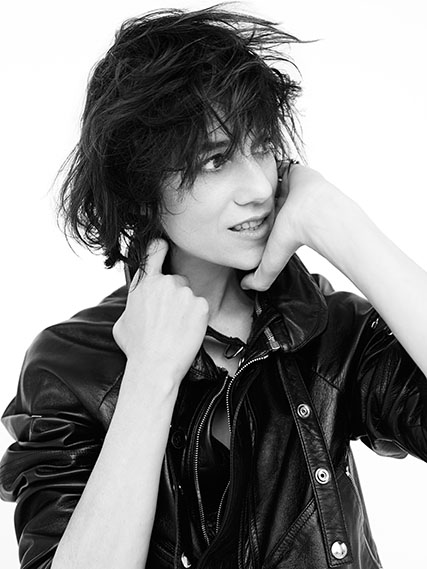
Photo by Amy Troost
We thought we knew almost everything there was to know about Charlotte Gainsbourg, so much so has the daughter, the sister, the mother, the wife, the actress and the singer, been a part of our cultural landscape since her very first steps were captured for eternity through a photographer’s lens. Yet in reality, we know very little: some scattered clues here and there in a body of work which lightly sketches a portrait of an elusive artist; secrets hidden away in songs portraying a muse seeming to carry the burden upon her shoulders of the iconic French status she’s inherited. Up until now, everyone has had his or her own image of Charlotte, but no one has ever questioned what her own version of it might be.
“I’ve always been a very private person, perhaps because my parents behaved in direct contrast to this,” she explains. “Faced with the scrutiny of the media it was important not give anything of myself away. I had a strong desire to put pen to paper and express myself and I’d made many attempts, but never quite found words I felt satisfied with. Despite encouragement from Beck or Connan Mockasin, I still had some deep-rooted complexes to overcome. In the shadow of my father, writing in French was something I’d never dared to do. But with the loss of my sister, I opened up without embarrassment; nothing mattered any more. I was in a period of intense grief and it was easier to express certain things.”
With her new album Rest, Charlotte unexpectedly reveals her own emotional autopsy to the listener in an uncompromising self-portrait, dissecting all of the star’s wounds and frailties: every scar is exposed. For the first time, Charlotte Gainsbourg lifts her veil: she wrote her own lyrics, often inspired by her journals; she chose to sing in French, to speak openly about her father’s death (Lying With You), about the passing of her sister (Kate), about her crippling shyness (I’m a Lie), about her childhood fears (Les Crocodiles), about the afterlife (Les Oxalis), about the passage of time (Ring a Ring a Roses) and her beating heart (Les Traits).
“I’m obsessed by this idea of ‘first times’,” she says. “There’s a certain charm and something magical that can never be found again afterwards. It’s the first time that I’ve surrendered myself and the end result belongs to me.”
The final album in its entirety creates an astonishing and exquisite map of the heart drawn by a modernist gothic heroine that prefers strobes to chandeliers and the company of drones to wolves. Think Jane Eyre flying a fighter jet. Charlotte successfully sheds her skin with such incredible frankness thanks to the trust she placed in the producer of the album SebastiAn, the artist that lit the fuse of French Touch 2.0 from the heart of the Ed Banger crew and the creative wizard behind the albums of Kavinsky and Frank Ocean.
“I believe his intensity and extreme way of expressing himself through music hides a form of shyness. I recognise this in myself so I’m confident he understands how I feel,” she says of her collaborative partner.
Their encounter galvanised Charlotte to come out from hiding, to lay down her protective armour and tell her story with candour, at times bordering on recklessness, yet without ever stepping over the proverbial line. The producer helped her navigate this precarious tightrope by creating an inspiring backdrop for her lyrics drawn—but never copied from—the iconic paternal songbook (the soundtrack for Tenue de Soirée, but most of all his epic English period), and mixing it with razor-sharp contemporary electro. As influences Gainsbourg freely cites composers of seventies French film scores (such as De Roubaix or Goraguer), the electro-pop maestro Moroder, as well as the oppressive atmosphere of films like Kubrick’s The Shining, Spielberg’s Jaws or Hitchcock’s Rebecca, which all have their own vision of fear, obsession and possession. With several years of self-imposed exile in New York already behind her, Gainsbourg appears to have achieved some distance between herself and her past and is now able to examine her emotions in a more objective light. She explains; “leaving for New York released me from the pressure I used to put myself under,” she recalls. “In France I learnt, at all costs, to protect myself. Over there, I discovered a new life, a new city and an incredible sense of freedom.”
Rest builds a bridge between England and France, between mother and father and delivers a constant dialogue around the subject of roots and bloodline, apparent in the lyrics—sung in French and English. Gainsbourg invites various artists to collaborate with her: Sir Paul McCartney, who wrote ‘Songbird in a Cage’ for her, and Guy-Manuel de Homem-Christo who composed and produced the track ‘Rest’. A wide range of musicians of different styles and traditions came together to create this very singular album: Connan Mockasin, Owen Pallet (Arcade Fire, Caribou, Franz Ferdinand), Emile Sorin (Forever Pavot), Vincent Taeger (Poni Hoax) and Tom Elmhirst (Frank Ocean, David Bowie, Jamie XX, Adele) who mixed the album. Rest is of course the first word inscribed on a headstone (Rest in Peace), and it’s also the word used by the French to plead with a lover not to leave: “through the toughness of the words chosen there lays—for me—an all-consuming love,” says Charlotte. An album of ashes and of the heart, Rest was almost titled Take One. This is a first take capturing Charlotte Gainsbourg’s intimate view of herself filtered through an uncompromising lens. Through 11 songs of troubled secrets, the artist has reached a place that can truly be called her own: by exploring her shadows she has managed to find the light
Last updated: November 1, 2017